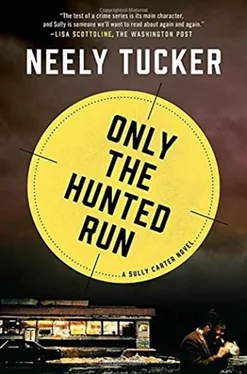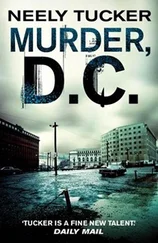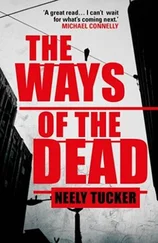“I got this headache, man. I think I’m going to throw up.”
“People often did, watching the procedure.”
“You seem to know a lot about this.”
“If one is interested in mental illness in America, one does. Freeman made lobotomy trips across the country. He’d show up at a state’s mental hospital and do twenty in an afternoon. He’d do the nervous housewives of the well-to-do.”
Sully, looking up now. “Oklahoma? He go through Oklahoma?”
Jerry shrugged. “Possibly. In the summers-by then, he was teaching here at G.W.-he’d barnstorm from here to California. A real evangelist. People would be stuck out there in small-town America with their depressed relatives-and then the great Dr. Freeman would come to town! He was a big name. People would bring their spouses, kids.”
“You are not going to sit there and tell me he drove an ice pick into the brains of children.”
“As young as eight. But see these pictures? No, the other ones. Those. They’re from South Dakota. That’s from the state hospital. He wasn’t happy with what the superintendents brought him.”
The photographs spread in front of him were grim. Faces of men, bent, gnarly as a tree root, pale, near hairless, twisted into a state so severe that Sully suddenly saw them on their own death tables, the undertaker having to break the legs to make them fit in the coffin.
“The superintendents would tend to bring him wards of the state, over sixty-five, all of them lifers, so if it was a disaster, who, really, was going to complain? Freeman wanted younger patients. Those on whom he could demonstrate improvement. So he took their portrait before the lobotomy and, when he caught up with them later, on his trip the next year or whatever, he’d take it again.”
“You’re going to tell me this guy wound up with an endowed chair.”
“Nah. Thorazine came along, like I said. People could take a pill and be better, live at home. It was the beginning of the end for warehousing the mentally ill, for lobotomies. Everybody else eventually stopped doing them. Freeman didn’t. License eventually jerked. Died in disgrace. More or less.”
Sully asked, “So I’m interested in Oklahoma. How would I find that out?”
“Gimme a minute.” Jerry slid off the table and disappeared into the back.
Sully rolled up his sleeves and walked from his table to the next, looking at the pictures Jerry had spread out. The dull faces, the heavy eyebrows, the lightless orbs in the sockets. What hellish world, he wondered, did they see, looking out? What voices echoed in the empty chambers of their minds? How did they see their keepers, as saviors or multiheaded monsters? The worlds of Lovecraft brought to life, an endless existence of mausoleum shadow and molten darkness?
Looking down into the boxes, opening one, then another, a tingling sensation crept over his shoulders and spread up his neck.
In the bottom of one lay two slender black-leather cases. Both had “Dr. Walter Freeman” embossed on the front, one in green, the other in gold. They looked like they had been expensive. They were both about a foot long and each was held closed by a pair of metal snaps, like an old eyeglass case. He reached down to pick them up, finding them heavier than he’d expected.
Jerry materialized at his shoulder.
“Here we go. The photographs from the trips, they’re categorized a couple of different ways, but mostly they’re kept in a box by state. Then the inside folders are kept by the institution, and then the patients are in alphabetical.” He paused. “I see you found the Holy Grail.”
Sully looked down at the leather case in his hand.
“This?”
“Open it.”
He popped open the snaps and pulled the cover back. Clasped to a felt backing by elastic bands was a steel ice pick, dull silver with gray to black spots. Below it was a similar-looking steel rod with a curved top that tapered to a needle-sharp point.
“You can pull them out,” Jerry said.
He did. The ice pick had, on the four sides of its slender handle, “Yolland Ice & Fuel Company.” It was heavy.
“The very first one,” Jerry said. “He thought it was like history, like Edison’s first lightbulb. When he donated his papers here, he mentioned these at the ceremony.”
The second case held two thicker but similar metal picks, with notches at the top and calibrations in millimeters. Each handle was engraved with FREEMAN.
“Those, he had machined specifically for the transorbitals. The notches there are centimeters. He thought that seven centimeters was the right depth for the first lobotomy. God only knows how he came up with that; he should have known from measuring all those corpses that there are differences in facial structure.”
“You said ‘the first lobotomy,’” Sully said, with a dull sense of horror.
“Yeah. You went home, you weren’t acting right, they’d bring you back and he’d knock it up to eight centimeters. Some people he lobotomized three times. The ice picks, he thought they weren’t quite sturdy enough. They could bend after you used them a couple of times. The leucotomes, though, as you can see, were just plain steel rods.”
“Leucotomes?”
“His word. He coined it. The instrument of lobotomies.”
Sully sat back down at his little table, heavy, looking at the paperwork, the narrow rods of glimmering steel in front of him. Jerry, taking the cue, said no rush, take your time, he was going to catch up on his filing.
Freeman had typed up the histories of each patient, usually three or four pages, stapled it, then paper-clipped them to the photographs, and dropped that in a manila folder with the patient’s name across the top. Failing that, he scribbled notes on the back of the photographs themselves. Notations about their age, profession, weight, relationships, sexual habits. The ones that did not do well, Sully was soon able to identify almost on sight-they were marked by only a few notes. Freeman, pitchman that he was, was far more interested in documenting his relative successes.
Miriam Harper, it turned out, was not all that hard to find.
Freeman had worked his way west on-what else-Route 66. That would have brought him right through Lincoln, on the very same road Sully had been on. He would have come in the summer, when the Harpers were at their place outside of town. Had Sully known to look, no doubt he would have found front-page notice of Freeman’s visit in the musty files of the Citizen .
William Harper, taciturn, humorless, would have opened the paper to see the news and taken the chance on the procedure more out of exasperation than love. What had Sly told him? That the family had not wanted Uncle Reggie back anymore? Maybe it was the same out there in the house by the lake. Maybe William Harper looked up from his paper, saw his delusional wife, and figured he had nothing to lose.
Miriam had been lobotomized at a doctor’s office in Lincoln, on June 15, 1961, Freeman’s file noted. In the first picture, taken before the procedure, she had a high forehead, cheekbones, dark hair pulled back into a severe bun. It would have been the day of her lobotomy-how could it not have been?-and she stood outside, on a sidewalk, the asphalt street and parked cars behind her. She looked at the photographer beyond the camera. She looked like she was staring at eternity. The attached notes had descriptions of her symptoms-agitation, outbursts, delusions, insomnia, violence.
The second photograph and attached note was from four years later. Miriam Harper, haggard, hair scattered, lopsided smile, Freeman taking the picture from five feet away.
This, then, was the grandmother George Harper grew up with. Haunted, empty eyes, vacant stare, errant hair, no makeup, sagging features.
Читать дальше








![Джон Макдональд - The Hunted [Short Story]](/books/433679/dzhon-makdonald-the-hunted-short-story-thumb.webp)



